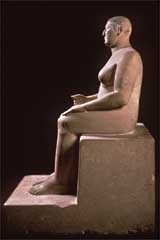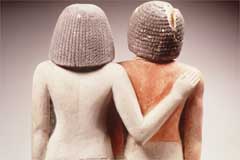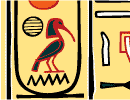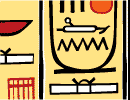The New York Times -- September 17, 1999
ART REVIEW
Egyptian Art: The Mysterious Lure of an Old
Friend
By MICHAEL KIMMELMAN
 EW
YORK -- A FEW years ago there was a traveling exhibition,
"Egyptomania," which showed how Greeks and Romans, then Italians,
French, Russians and Americans borrowed, copied and stole from ancient Egypt, or what they believed
was ancient Egypt because after a while the copies and
adaptations got mixed up with originals and became part of the
evolving culture.
EW
YORK -- A FEW years ago there was a traveling exhibition,
"Egyptomania," which showed how Greeks and Romans, then Italians,
French, Russians and Americans borrowed, copied and stole from ancient Egypt, or what they believed
was ancient Egypt because after a while the copies and
adaptations got mixed up with originals and became part of the
evolving culture.
|

The Metropolitan Museum of Art
|
Hemiunu, the prince in charge of
building the Great Pyramid.
|
Obelisks, pyramids and all the other Egyptian-derived forms, which
for centuries, even before the great excavations of the 19th century,
permeated Western art and architecture (the Egyptian Hall in London,
the original Tombs in lower Manhattan, the old suspension bridge over
the Neva in St. Petersburg, the Pyramid at the Louvre in Paris and on
and on) proved that the Egyptians succeeded, to a degree probably even
they didn't anticipate, in leaving a legacy to outlast themselves.
A major show of Old Kingdom art, now at the Metropolitan, easily
gets the early vote for blockbuster of the fall season. Organized at
the museum by Dorothea Arnold and handsomely installed, it's one of
those spectacles, like the Byzantine, Chinese and Mexican surveys that
the Met has done in recent years, that is not just about art but about
a whole civilization. It examines the first great epoch in
Egypt, the 500 years from 2650 to 2150 B.C., which is really
the high point of all ancient Egyptian culture, when the
pyramids were built and the canon of Egyptian art was established. As
well as any show, it demonstrates why Egyptian art still holds an
incredible fascination in the West.
Considering the number and popularity of exhibitions about New
Kingdom pharaohs like Tutankhamen and Amenhotep III, it's a little
surprising that this is actually the first big survey devoted to Old
Kingdom art, but evidently there hasn't been an excuse to do a show
until lately, and museums generally need some excuse for moving around
some of the oldest sculptures in history. The excuse here is that
experts, who for a long time didn't pay much attention to the Old
Kingdom because it seemed like a settled subject, have been fiddling
with the chronology of some of the objects on view. Those of us who
aren't Egyptologists will simply be grateful for the chance to peruse
work that, aside from being astonishingly beautiful, has continued to
seem over thousands of years mysteriously impenetrable and familiar at
the same time.
No doubt this is a reason for Egypt's fascination: its
paradoxical status in our imagination. We think of Egypt as
both complex (hieroglyphs, religion) and, in a formal sense,
rudimentary (the pyramids). Children, for instance, are always drawn,
as if genetically programmed, to the Egyptian section of a museum
because Egyptian art seems immediately understandable to them. To a
child learning to read, hieroglyphs are colorful, eye-catching
pictures, unlike letters of the alphabet, and Egyptian statues, with
their predictable, straightforward attitude toward the viewer, look
like people pared down to basic forms, which is how a child is
inclined to draw.
Adults admire the same art for opposite reasons: it seems abstract
and sophisticated in the sense that we know it depends on a remote
philosophy of nature, religion, authority, class, beauty and death.
Adults always say how Egyptian art looks modern, by which we really
mean that modern art has evolved complicated forms of abstraction,
symbolism and linear representation, many of which ultimately descend
from the Egyptians.
The art is abstract and illusionistic simultaneously. A landmark of
the Old Kingdom from the Fourth Dynasty (2575-2465 B.C.) is the famous
seated statue of Hemiunu, the prince and vizier in charge of building
the Great Pyramid. It's one of the first things that occupies your
attention in the show. Hemiunu is kind of a pyramid himself, a
triangular mass of limestone, life size, straight-backed, feet firmly
planted side by side, hands resting on his lap, one palm down, the
other closed, with a look on his face of divine indifference.
And he's fat -- his large breasts two grapefruits, his huge arms
slack over a frame that, to judge by his head, seems barely sufficient
for his size, his undulating belly sagging under the weight of his
flesh. (You see this best straight on.) A different portrait of him, a
small profile in relief, also in the show, makes him look more
youthful, less forbidding but still fine-featured and strong-jawed, so
that between the two versions we feel we have some idea of what he
actually may have looked like.
This was the essence of Egyptian portraiture: to find a way, within
strict parameters, to convey particularity -- to combine, in a sense,
what one knows with what one sees. Accurate observation was necessary
to fulfill the immortalizing function of Egyptian art -- to be a true
embodiment of the person in stone through eternity -- but observation
always had to be modified by convention.

The Metropolitan Museum of Art
|
Intimate detail: The back of a
sculpture of Iai-ib and Khuaut, husband and wife.
|
You could say that this remark applies to all art, which it does,
but with Egyptian art the limits of convention were unusually
specific. The standard Egyptian relief portrait, as it came to be
established during the Old Kingdom, required each part of the body to
be presented in strict proportion, with its essential aspect to the
viewer (shoulders forward, head turned, legs sideways and striding).
An icon of Egyptian art, anatomically impossible, it's also a
strangely lifelike arrangement.
The artist who carved the relief of Hesi-re, the Third Dynasty
(2649-2575 B.C.) scribe, found a way to obey this formula without
being formulaic and to make us see someone in particular: a tall,
slender young man, serious, with alert eyes, high cheekbones, hooked
nose, narrow mouth, faint mustache and sinewy arms.
We have no idea who the artist was, but while artists didn't carve
their own names into these sculptures, we can tell the good workshops
from the less good ones: the workshop, say, that sculptured the triad
of the Fourth Dynasty king, Menkaure with two goddesses, as opposed to
the one that made the little statues of Inti-Shedu, an artisan --
although they both convey a humane understanding. Some of the most
memorable works aren't the biggest or the fanciest, in fact; they're
sculptures like the one of Iai-ib and Khuaut, husband and wife, side
by side.
She is a little behind him, shorter and standing so close to him
that her right breast presses against his arm. You can make out her
body beneath her sheath dress -- the belly, thighs, hip bones and
back. It's the back that makes the sculpture special: her arm reaches
around him, her hand on his shoulder, an intimate detail that comes as
a particular surprise because it's invisible from the front. We err to
think of Egyptian art as monotonous, even monotonous in a stately,
incantatory way (a common remark). More accurate is to say that it's
an art of subtle variation, especially impressive for operating within
such a strict code.
The Old Kingdom peaked artistically during the Fourth and Fifth
Dynasties (together 2575-2323 B.C.). From the Sixth Dynasty are the
famous statue of Queen Ankh-nes-meryre II with her son, Pepi II, fully
grown in miniature form, sitting on her lap (every mother's dream),
and various standing wood figures of seal bearers, slim, muscular,
vacant-faced, a little toylike but elegant in silhouette. Still, the
essential forms of Egyptian art were in place earlier, when they more
clearly expressed the central Egyptian paradigms of permanence and
immobility.
Egyptian art, after all, was ultimately about death, or more to the
point, it was about eternal life after death, about achieving a
suspended state of grace (another source of Egypt's eternal
fascination for us). What remains of Old Kingdom Egypt are
tombs, or objects from tombs, which represented and recreated the
lives of the people buried. As the textbooks always remind us,
Egyptians made stone sculptures not for the sake of art as we think of
it today but as a duplicate of the living world to be occupied by the
dead, or to be precise about it, by their ka, the life force.
Sculptures of the pharaohs were permanent bodies made of stone to
replace the flesh ones they left behind.
"The Egyptians say that their houses are only temporary lodgings
and their graves are their real houses," is how Diodorus Siculus, the
ancient Greek historian, famously put it (although he might
have added that this sufficed nicely for kings, queens and high
officials with big graves, while for the masses of Egyptians, home for
eternity was a shallow pit).
It's a final, intriguing paradox that an art about death should
teem with so much life. As Ms. Arnold, the curator, writes, "The
essence of Old Kingdom art is joy in life," which is exactly right.
The show is full of paintings, relief scenes and small sculptures of
contented laborers, fishermen, musicians and cooks. Men and women are
always made to look beautiful, even when they're fat or old or dwarfs;
Egyptians depicted everyone with a respect for the diversity of
humanity.
They embraced the ordinary in the afterlife, something that
separates their view of life from our notions of death, which are
fixated on heaven, hell and oblivion. Time after time in the
exhibition, in the way that one experiences small epiphanies by being
alert to what happens all the time on the street, our attention is
drawn to little details from the everyday world: the sexy torso of
Lady Hetep-heres, a statue from the Fourth Dynasty; two orioles
fighting, from a Fifth Dynasty limestone panel; sailors on a ship,
from a relief of the late Fourth Dynasty or early Fifth Dynasty. The
artist who carved that scene demonstrates the Egyptians' mastery of
abstract line drawing, the image being a complicated crisscross of
ropes, oars, legs and masts; even the water under the boat is made
into a kind of braid, jewel-like.
And this is what the best Old Kingdom art is about: conveying the
basic elegance and pleasure of everyday forms in a form that is,
itself, elegant. One relief in the show has a herd of cattle crossing
a canal. The herd is lined up in a strict row except for a cow in
front whose head rears to lick her calf riding on the back of a
herdsman. It's a herdsman's trick for coaxing cows through water: the
mother will follow the calf and the herd will follow her.
The calf here turns around and touches its tongue to its mother's
tongue. An ordinary image becomes something else. The panel was carved
for the tomb of a high Sixth Dynasty official named Ni-ankh-nesut and
is a funerary monument to sweet life.





